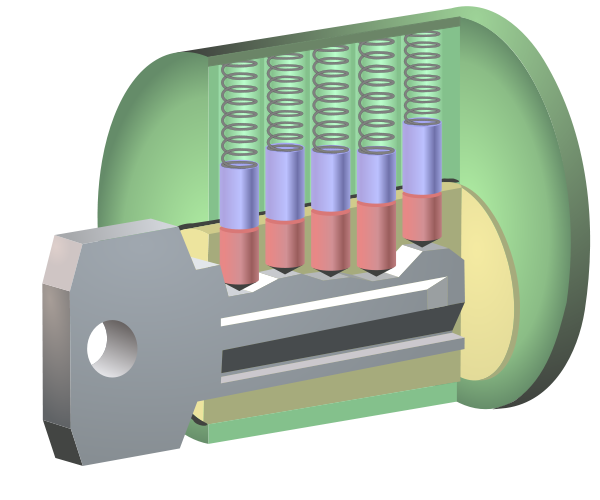Lock Bumping

Unless a thief or other miscreant knows about “lock bumping.”
Most pin tumbler locks are vulnerable to this crude, inexpensive to exploit flaw, which requires nothing more than a hammer and something called a “bump key.” The bump key is a special type of key with shallow, uniform teeth, allowing it to be inserted into the lock without risk of being thwarted by the presence of a deep pin stack. The bump key is inserted almost entirely into the lock, with one slot left exposed outside the mechanism. (The key will be pushed fully into place by the hammer rap to follow.) Once the bump key is properly inserted, the key pins rest on it while the driver pins, in turn, rest on the key pins with springs extended.
The villian then, ever so slightly, tries (at this point, in vain) to turn the key, but again, only slightly. The goal here is not to push the driver pins against their chambers, locking them in place, but to get the key going in the right direction when the magic happens in the next, and final, step. Our bogeyman takes the hammer and bangs it firmly against the key. The force exerted by the hammer is transferred to the key pins, and, like the desk top toy Newton’s Cradle, causes the key pins and driver pins to separate for a fraction of a second. And because the key is already being slightly turned, this momentary separation is more than enough time for the locking mechanism to be disabled. The key turns and the lock is unlocked.
Is your lock vulnerable? Most likely, yes, although many newer pin tumbler locks come with countermeasures, such as foam inserts which absorb the force from bumps.
Bonus fact: Magician Harry Houdini was a master lock picker, often performing his tricks without aid of a hidden key. How? Some locks would open simply by banging the cuff firmly against a hard surface — which he demonstrated in front of a German judge in 1902, defending himself in a slander trial.
From the Archives: Hairy Houdini: Another escape artist (and the name isn’t a typo).
Related: Newton’s Cradle — perhaps the best (albeit annoying once the novelty factor wanes) desk toy ever made.

Leave a comment